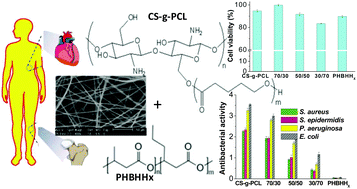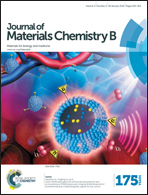Electrospun fibers of chitosan-grafted polycaprolactone/poly(3-hydroxybutyrate-co-3-hydroxyhexanoate) blends†
Abstract
Chitosan-grafted polycaprolactone (CS-g-PCL)/poly(3-hydroxybutyrate-co-3-hydroxyhexanoate) (PHBHHx) fiber blends were prepared via wet electrospinning, and their morphology, hydrophilicity, water absorption, biodegradation, cytotoxicity, and thermal, mechanical and antibacterial properties were analyzed. IR spectra revealed strong H-bonding interactions between CS-g-PCL and PHBHHx. SEM and DSC analysis confirmed the immiscibility of the blends at all compositions studied. As the proportion of CS-g-PCL increased, the overall crystallinity of the blends increased, the melting temperature of PCL decreased, and each component promoted the crystallization of the others. The hydrophilicity, water absorption and weight loss in buffered solution decreased as the PHBHHx content increased. DMA and tensile tests indicated a synergistic effect on the mechanical properties at a blend composition of 70/30, leading to an optimal combination of stiffness, strength, ductility and toughness. The fibers retained adequate rigidity and strength under physiological conditions. The 70/30 blend exhibited the highest biocide action against Gram-positive and Gram-negative bacteria. The fibers did not induce toxicity over human dermal fibroblasts. These biodegradable, biocompatible electrospun fibers could be used as scaffolds for tissue engineering.

- This article is part of the themed collection: 2015 Journal of Materials Chemistry B Hot Papers

 Please wait while we load your content...
Please wait while we load your content...